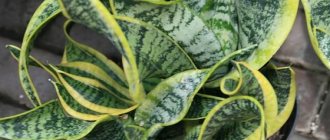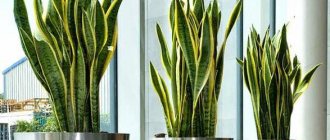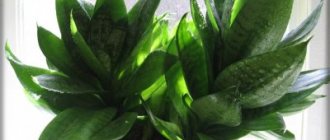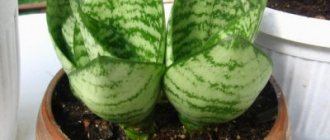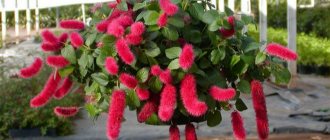What kind of soil does sansevieria need?
The plant does not like acidic soils - the skin on the flower cracks due to the high nitrogen content. The best option is soil with a neutral pH (6-7). The loose, light structure provides good aeration to the roots.
Sansevieria
The substrate for transplanting sansevieria is prepared according to the following recipe:
- add the same amount of sand to the 1st part of peat;
- add 3 parts of turf or leaf soil, as well as ½ part of humus;
- add a little vermiculite or perlite to the mixture (to absorb excess moisture);
- the substrate is poured into a pot and used to transplant the flower.
You can also take a different soil composition: from sand, deciduous and turf soil in a ratio of 2:2:6, respectively.
Growth rate
Sansevieria is a succulent, so it grows slowly. If a flower does not have enough light, growth and development slow down. A pot that is too large can also negatively affect its growth rate. The flower should be protected from direct sunlight; it should be provided with diffused light and moderate watering.
To improve growth, the plant can be planted in open ground in April, or a flower pot can be placed on the veranda or loggia. The main thing is to get him home before the cold weather sets in.
How fast does Sansevieria grow?
The question of how to transplant a pike tail rarely arises among gardeners - this plant develops very slowly. It would be more relevant to ask when this procedure should be performed.
Pike tail flower - care and reproduction
Mother-in-law's tongue (another name for the plant) can develop freely in one container for 2-3 years. Time is not a reason to move. The signal for a transplant will be the following moments:
- separate rosettes have formed on young leaves;
- the plant is cramped, roots are visible from the drain hole at the bottom of the pot;
- Sansevieria began to wither, turn yellow, curl up, curl up.
Note! The latter reason is often provoked by improper care, leading to rotting of the roots. To verify the condition of the underground part of the plant, it will have to be removed from the pot. Having tidied up the roots, it is wiser to immediately allocate a new container for the pike tail.
Transfer rules
Mother-in-law's tongue flower - home care
If you ignore the plant's signals that it is time to change the pot, it will continue to develop and begin to become deformed. In order for Sansevieria to feel comfortable, transplantation at home is carried out in compliance with the requirements:
- in pike tail, the roots are located close to the surface, so when choosing a container, take into account not the depth, but the width;
- the new pot should be only 10% larger than the previous one - the root system of this plant likes close quarters;
- The stability of the container is important - Sansevieria is a heavy plant (especially tall species).
Transplanting into a new pot
Note! The material from which the pot is made also matters. To prevent the container from bursting under the pressure of the roots, it must have thick walls. Therefore, it is better to take a clay container for the flower.
Variety of species and varieties
Of course, this is a bold attempt to try to list all the varieties and varieties of this amazing plant in a short article. The uniqueness of the hybrids is manifested in the shape and color of the leaves. Stamina remains the same for all species. The original natural species that gave rise to the selection of varieties is Sansevieria three-striped (three-striped) .
Table: natural types of sansevieria
| Species name | Characteristic | Note |
| Sansevieria three-striped |
| The most common type. In room conditions it reaches 1 m in height or more. |
| Sansevieria cylindrica |
| A deep groove is visible on the leaves. |
| Sansevieria pickaxe | Forms rosettes of 2–3 leaves, the color is a calm shade of green with light grayish or greenish spots. The leaves have a red edge. | Some varieties may have entirely reddish or brown leaves. |
| Sansevieria liberia |
| Originating from tropical West Africa, the name is associated with the country of Liberia. |
| Sansevieria graceful, or graceful | Leaves are up to 30 cm long, pointed towards the apex. The color is gray-green, with brownish-beige or light gray transverse stripes. | The leaves form tubes at the ends. |
| Sansevieria duneri |
| Sometimes the number of leaves in a rosette reaches two dozen. |
| Sansevieria hyacinth | The leaves are lanceolate, collected in bunches of 2 to 4 pieces, width from 2–3 to 7 cm, tapering towards the base. The length of the leaves usually does not exceed 50 cm. | The usual flowering time is winter. The flowers are small, with a very pleasant smell. |
| Sansevieria large | The leaves are up to 15 cm wide, close to wide ovals in shape, without a pointed tip. The color is most often intense green with darker transverse stripes. | Originally from the tropics of Africa. It is not one of the tallest, its height is on average 40–60 cm, but due to the width and apparent massiveness of the leaves it gives the impression of being solid and “big”. |
How to plant pike tail at home
Sansevieria does not have a dormant period, so the time to move to a new container can come in any season. Having prepared the pot and soil, study the algorithm on how to transplant sansevieria correctly:
- taking a knife in your hand, run its blunt side along the inner wall of the pot - this will make it easier to remove the flower;
- the pike tail is placed in a basin and the old soil is washed off from the roots with a stream of water;
- the bottom of the new container is covered with expanded clay, on top of which a 1/3 layer of fresh substrate is poured;
- Place the plant in the center, carefully leveling the roots;
- pour a little earth around the flower and compact it.
Gatsania flower - how it blooms on a club, what soil is needed for growing
The last step is repeated until the container is filled with soil. In this case, each layer is slightly moistened with water at room temperature.
Important! When replanting sansevieria, take into account the size of the plant. If the bush is several years old, it has tall, heavy leaves. Therefore, while rooting in the new pot, the pike tail will need reliable fixation.
What you can and cannot eat during Lent
It is noted that in the Christian church calendar there are several fasts, and the most important and important of them is Lent. The fact is that from time immemorial, Orthodox believers during it observed the most strict rules regarding both diet and some other things in life. It is known that after Lent, Christians celebrate an equally important celebration - Easter, which officially ends the fast.
Sansevieria propagation
If the time to plant mother-in-law's tongue was in the spring, you can combine this procedure with propagation. During this period, all biological processes are proceeding at an accelerated pace; the active movement of juices will help the plant take root faster.
Novice gardeners are interested in the question of how Sansevieria reproduces. This activity is carried out in several ways:
- division of rhizomes;
- cutting off side shoots;
- fragments of a leaf plate.
The latter option does not allow preserving the color of some types of pike tail, but the method still remains popular. This method is especially good if the root system has become sick and unusable.
Preparing for transplant
Leaf
You can also use the propagation of Sansevieria by leaf in the case when an already formed plate breaks off. At the same time, mother-in-law’s tongue can be rooted both in the soil and in a cylindrical container with water.
The soil
In order for Sansevieria to take root, propagation by leaf is carried out in a soil other than that intended for replanting the flower. In this case, the loose substrate should contain components in the following proportion:
- 1 part of sand and humus;
- 2 parts each of turf and leaf soil;
- The presence of charcoal is required.
Another composition is also suitable for propagation: from leaf and turf soil with the addition of perlite (all ingredients are taken in equal parts). The soil must be sterile (calcined) and moist before planting.
What kind of pot do you need?
The rules for choosing a container for a pike tail were mentioned above. The cuttings with which the plant will be propagated are small in size. Therefore, you should not take a spacious pot. For starters, a container no more than 8 cm in diameter and about 5-6 cm deep is quite suitable.
As for the material of the pot, it must be breathable so that future roots can breathe. Ceramics (clay) are best suited for this. In addition, it perfectly absorbs water, acting as additional drainage.
Agricultural technology
To know how to properly propagate sansevieria by leaf, follow the step-by-step instructions. At the same time, despite the general aspects, there are differences in earth and water rooting.
Leaf propagation
First perform the following actions:
- cut a healthy, undamaged leaf from the mother bush;
- the plate is cut into strips of 10-15 cm, moving with a sharp knife perpendicular to the veins;
- On each fragment, the bottom and top are marked with a marker (this is important when planting).
Important! If part of the plate is buried in the ground or lowered into water with the wrong cut (against the flow of juices), you may not expect roots.
Peculiarities of propagation of Sansevieria by leaf
| In the ground | In water |
|
|
Planting leaf parts directly into the substrate is preferable - rooting will occur faster (in 1.5-2 months). New shoots from the leaf can be expected in 7-8 months. For this to happen, optimal conditions are maintained:
- air temperature – within 21-25°;
- luminous flux - only diffused;
- substrate – moderately moistened (watering through a tray).
Note! When propagated by leaves of mother-in-law's tongue, some gardeners practice the greenhouse effect. It is undesirable to do this - due to increased humidity, the cuttings may rot.
Why remove the growing point of Sansevieria?
The goal of propagation is not just to get a new plant, but also to preserve all its characteristics. Not every method satisfies this desire. In varieties with variegated leaves, color can only be preserved by propagation by layering.
The older the plant, the less likely it is to get planting material from it. After 5 years, the flower practically does not form root layers. To stimulate the queen cell to develop, you need to carefully cut out (not twist) the growth point and remove the top 2-3 leaves.
Sansevieria with layerings
The plant will immediately redirect its forces to the development of the rhizome; after 1.5 months, several good layering will develop on the bush. They are cut off and planted in pots. After this, an adult Sansevieria can grow for several more years (until the foliage dies).
Ready mixes
Although professional gardeners prefer to prepare soil for planting themselves, commercially available soil for succulents is quite suitable for amateurs . The composition of this soil is based on peat. It can be high and low.
High-moor peat is very light and poor in nutrients and can retain moisture for a long time. Lowland peat is heavier, it cakes quickly, which is why sand is often added to it.
The price of ready-made soil for succulents in Moscow is about 80 rubles . In St. Petersburg, the price is approximately the same and can vary greatly among different manufacturers.
If Sansevieria does not grow
The simplest reason why the mother-in-law's tongue stopped developing is the excessive crampedness of the potty. If a young plant has stopped growing, you should pay attention to the care conditions:
- improper watering;
- bright sunlight or shading;
- low temperatures;
- draft.
All these factors not only slow down development, but also become causes of Sansevieria disease. The plant itself will signal the problem.
Pike tongue has soft leaves
First, the plates begin to turn yellow, then soften at the base. The situation is caused by waterlogging of the soil. The only way to really save the situation is by transplanting it into a new pot. To do this, perform the following steps:
- the flower is carefully removed from the container;
- the roots are freed from the ground and inspected;
Note! If the root system has rotted, there is no point in resuscitating the entire plant.
- soft yellow leaves are removed.
Fresh soil is poured into a new container and the sprout is planted in it. The pot is placed away from the sun's rays and the watering regime is monitored.
Why do Sansevieria have limp leaves?
The opposite situation, when the soil is too dry, leads to lethargy of the plant (especially if the room temperature is below +15°). A quick way to bring Sansevieria to life is to move the pot to a warm place, remove the flaccid plates and water the soil.
Mother-in-law's drooping tongue
If signs of trunk rot are noticed, it is better to cut off the undamaged parts of the leaves and root them in a new container. Throw away the remains of the diseased plant.
Other developmental problems
Sansevieria, like cactus, does not like frequent watering. Excess moisture, as well as violation of other regimes, lead to serious deviations in the development of the pike tail.
How to fix sansevieria problems
| Sign | Cause | Recipe for resuscitation |
| Twisting | Leaves may curl due to lack of moisture | It is enough to establish regular, but not frequent watering, and the plant will stop curling |
| Rugosity | Affected by prolonged exposure to shade and lack of moisture. | The light regime is corrected by gradually moving the pot towards the window. After this, watering is adjusted |
| The leaves have fallen | Evidence that the plant is cold | It is enough to move the flower to a warm room, and the foliage will quickly straighten |
Knowing what sign indicates a problem, it is easier to understand why Sansevieria leaves curl (wither, turn yellow, etc.). This will allow you to provide first aid to the plant in time and establish proper care.
Care
The soil itself does not require special care, but it should be disinfected to avoid the appearance of pests. To do this, you need to steam it in a water bath in a colander or bake it in the oven.
Nitrogen fertilizers harm succulents, so it is better to use potassium fertilizers. As a top dressing, you can buy ready-made mixtures.
Sansevierias do not like a lot of moisture; frequent watering harms them and triggers putrefactive processes, so you need to water the ground no more than once a week. You also need to avoid getting moisture on the leaves of the plant. In winter, it is worth watering the soil about once a month.
You may be interested in reading our other articles about the nuances of caring for sansevieria:
- How to replant this plant correctly?
- How to propagate by leaf?
- What diseases and pests can destroy a flower?
Although Sansevieria does not require special soil, it is still useful to know what kind of soil this plant thrives on, how to prepare the soil and care for it. The better the plant is cared for, the better it will develop and delight the owner with striped green leaves.
